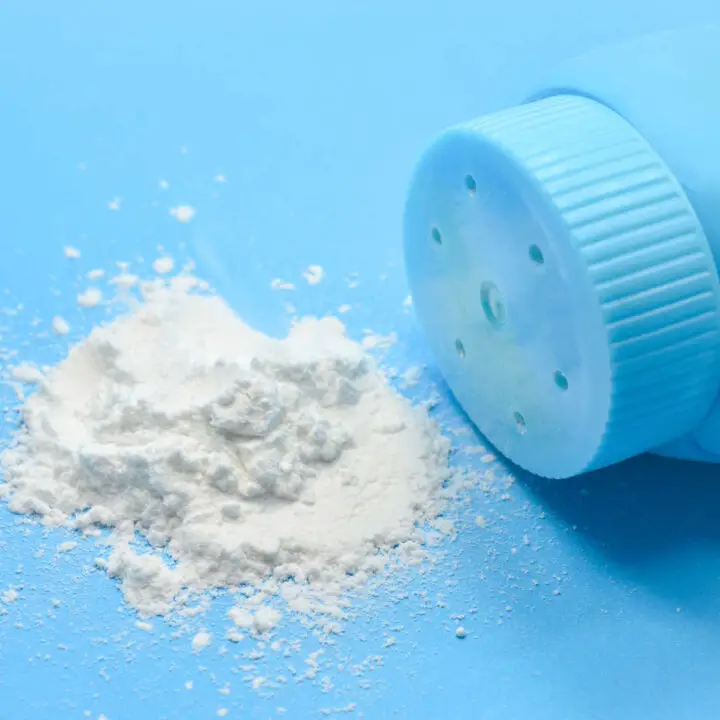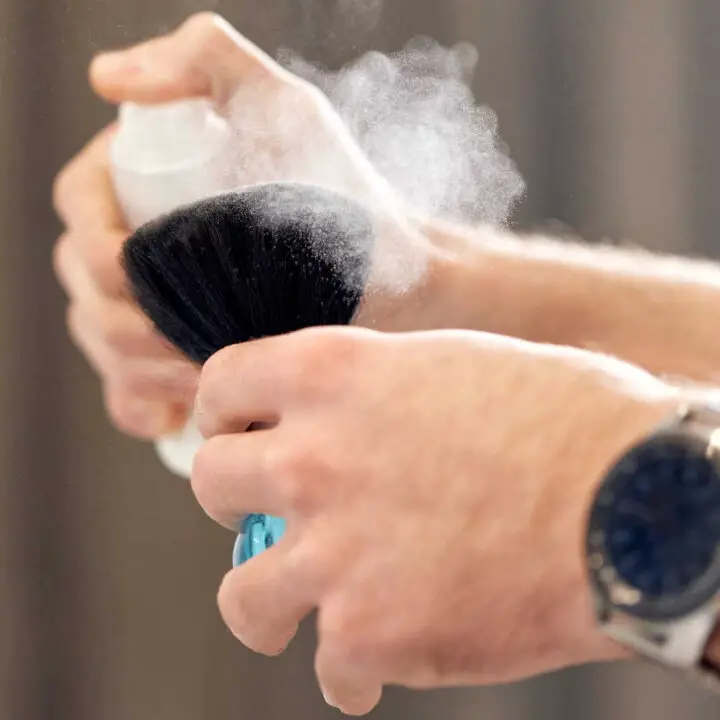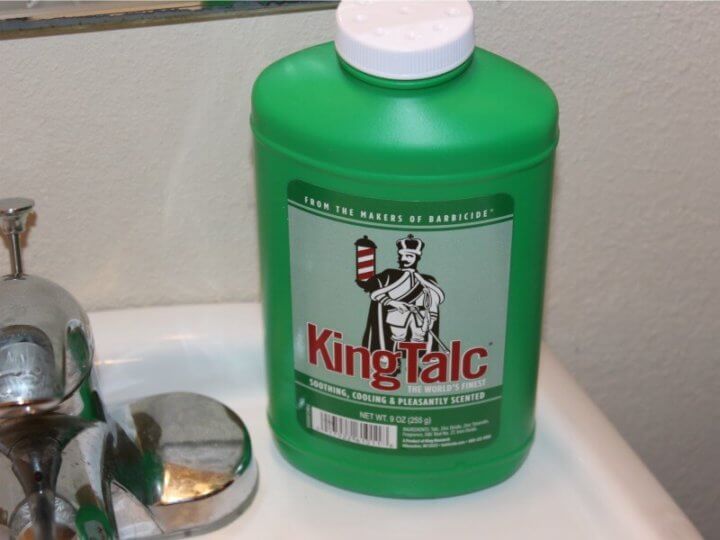
Trouble with razor burn and skin irritation from wet shaving? You’re not alone. In fact, talcum powder may be a solution, as it is known for reducing friction and preventing rashes.
This article will shed light on everything you need to know about talcum powder – its composition, uses, safety concerns, and links to health risks like cancer. This is a major update to an article that first appeared here in 2014!
What is Talcum Powder?
Talcum powder is a mineral-based powder made from talc, a silicate mineral composed of magnesium, silicon, and oxygen.
Composition and properties of talcum powder
Talcum powder, also known as talc, is a clay mineral composed of hydrated magnesium silicate. Its softness and heat resistance make it an ideal component in many cosmetic products.
The fine granules can absorb moisture, reduce friction, and prevent rashes or skin irritation. This makes talcum powder beneficial for men who wet shave because it leaves the skin feeling smooth and comfortable after each shave.
Many people use it to design their personal hygiene routine based on its fragrance-enhancing property as well. Talcum powder appears white in color due to its high brightness levels, offering aesthetic appeal which attracts men towards using this product during their grooming processes.
Common uses of talcum powder
Talcum powder, a product derived from the mineral talc, is used extensively in daily routines and various industries.
- It serves as an essential ingredient in cosmetics. Women use it as a setting powder to give makeup a finished look.
- Barbers often apply talcum powder to lessen skin irritation after a shave.
- People sprinkle it on their bodies for its moisture absorption properties that keep skin dry.
- It also finds use in baby powders to prevent diaper rash due to its ability to reduce friction.
- Talcum powder is included in beauty products like blush and eyeshadow for its texture and absorbency characteristics.
- In the textile and paper making industry, it’s employed because of its anti – stick and marking features.
The Link Between Talcum Powder and Cancer

Studies and research have shown a potential link between talcum powder use and the development of certain types of cancer.
Studies and research on the connection
Scientific studies have uncovered a possible connection between talcum powder and cancer in women. Researchers discovered that when talc is used in the genital area, it can travel through the reproductive system to the ovaries.
Once there, it creates inflammation which increases the risk of ovarian cancer. Additionally, inhalation of talcum powder might lead to lung issues or respiratory problems.
The International Agency for Research on Cancer (IARC) classifies genital use of talc-based body powder as “possibly carcinogenic to humans.” However, experts state that these findings do not confirm that using baby or body powders will cause cancer but merely indicate a modest increase in risk associated with long-term use.
It’s crucial for users to stay informed about ongoing research and potential risks related to this commonly used product.
Potential risks and controversies
Talcum powder has been the subject of potential risks and controversies, particularly regarding its link to cancer. Numerous studies and research have examined this connection, with some suggesting that long-term use of talcum powder in the genital area may increase the risk of ovarian cancer in women.
However, it’s important to note that findings have been mixed, and more research is needed to establish a conclusive link. Despite these concerns, many regulatory authorities still consider talcum powder safe for general use, especially when using cosmetic-grade products that are asbestos-free.
It is crucial for individuals to review the available information and make informed decisions about their usage based on personal preferences and health considerations.
Industrial grade vs. food grade talcum powder
Industrial grade and food grade talcum powder are two different types of the same substance, each with its unique properties and uses. As a man who wet shaves, it’s important to understand the distinctions between these two types to ensure your safety and the optimal results from your grooming routine.
| Parameters | Industrial Grade Talcum Powder | Food Grade Talcum Powder |
| Purity | Contains traces of other minerals which may include asbestos. | Highly purified to ensure it’s free from minerals like asbestos. |
| Usage | Used in industries for manufacturing processes. | Used in food processing and personal care products. |
| Safety Concerns | Potential asbestos contamination can pose health risks. | Generally safe for use in food and cosmetics, though some concerns about potential health risks remain. |
| Regulations | Mandated by industrial safety norms. | Regulated by the FDA for safety and purity. |
It is crucial for men who wet shave to ensure that they are using food-grade talcum powder, which is specifically manufactured for personal care use, adheres to strict safety standards, and is the safest option for direct skin contact. This is especially important considering the sensitive nature of facial skin and the potential long-term effects of daily shaving.
Association with asbestos and legal cases
Talcum powder has been associated with asbestos contamination, which has led to numerous legal cases. Asbestos is a harmful mineral that was sometimes found in talc deposits, and exposure to it can cause serious health issues, including lung cancer and mesothelioma.
In the past, some talcum powders were contaminated with asbestos due to being mined from areas where asbestos was present. This led to lawsuits against manufacturers who failed to warn consumers about the potential risks.
The legal cases surrounding talcum powder have brought attention to the importance of product safety and transparency in the industry.
Alternatives and Recommendations

Safer alternatives to talcum powder include cornstarch, arrowroot powder, and baking soda. These natural powders can provide similar moisture-absorbing benefits without the potential risks associated with talc.
It is important to read labels carefully and choose products specifically marketed as talc-free alternatives for personal care and hygiene needs.
Safer alternatives to talcum powder
Choose safer alternatives to talcum powder for a healthier grooming routine. Consider the following options:
- Cornstarch: A common substitute for talcum powder, cornstarch has moisture-absorbing properties that help keep your skin dry and prevent friction.
- Arrowroot powder: Similar to cornstarch, arrowroot powder is a natural alternative that can be used as a talc-free option for absorbing moisture and reducing irritation.
- Baking soda: Known for its absorbent qualities, baking soda can be used sparingly as a substitute for talcum powder. It helps control odor and keeps your skin feeling fresh.
- Kaolin clay: This gentle clay mineral can be used as an alternative to talcum powder. It absorbs excess moisture without clogging pores or causing irritation.
- Natural body powders: Look for products that are specifically formulated with natural ingredients like essential oils, plant-based starches, and clays to provide similar benefits to talcum powder without the potential risks.
Precautions and guidelines for usage
To ensure safe usage of talcum powder while wet shaving, follow these precautions and guidelines:
- Use sparingly: Apply a small amount of talcum powder to your wet skin. A little goes a long way in reducing friction.
- Avoid open wounds: Do not apply talcum powder to cuts or abrasions as it may cause irritation or infection.
- Keep away from the eyes: Be cautious while applying talcum powder near your eyes as it can cause irritation and discomfort.
- Use on dry skin: Ensure that your skin is completely dry before applying talcum powder to maximize its moisture-absorbing properties.
- Store properly: Keep your talcum powder in a cool, dry place away from moisture and excessive heat to maintain its effectiveness.
- Check for any adverse reactions: Stop using talcum powder immediately if you experience any redness, itching, or other allergic reactions.
Products

[Note: Amazon links are affiliate.]
Here are several products that approach shaving talcum powder in different ways:
Pinaud Clubman Talc is probably the classic, primarily using talc, zinc oxide, and zinc stearate (to cut down on friction) as major ingredients.
Taylor of Old Bond Street’s “Luxury Talcum Powder” uses talc and magnesium carbonate (often used by rock climbers and gymnasts) as its primary ingredients.
New York Shaving Company’s “After Shave Powder” specifically says it’s talc free, instead relying on a mix of kaolin, corn starch, tapioca starch, and other ingredients.
Johnny B Professional Barber Talc contains Zea Mays (Corn) Starch, Aluminum Starch Octenylsuccinate, Talc, Fragrance (Parfum), Blue 2 Lake
Conclusion
In conclusion, talcum powder is a mineral-based product commonly used for its moisture-absorbing properties in cosmetics and personal care products. However, there have been concerns about its link to cancer due to potential contamination with asbestos.
It’s important to weigh the potential risks and consider safer alternatives when using talcum powder.
FAQs
1. Is talcum powder safe to use?
Yes, talcum powder is generally considered safe for use on the body. However, it is important to follow proper usage instructions and avoid inhalation.
2. Can talcum powder cause cancer?
There have been some studies suggesting a possible link between talcum powder and ovarian cancer in women who regularly use it in the genital area. However, more research is needed to establish a conclusive connection.
3. What are the common uses of talcum powder?
Talcum powder is commonly used for personal hygiene purposes such as drying and freshening the skin, preventing chafing, and absorbing moisture.
4. Are there any alternatives to using talcum powder?
Yes, there are alternative products available such as cornstarch-based powders or powders made from natural ingredients like arrowroot or baking soda.
5. Should I be concerned about using talcum powder on infants?
There have been concerns about potential respiratory issues if babies inhale large amounts of talc particles. It’s best to consult with a pediatrician for advice on suitable alternatives or usage guidelines for your baby’s specific needs.

I’m an original Old Spice (OS) fan and user; along with the OS shaving soap, cologne and after shave, there was the after shave talc. I’m assuming it was industrial grade (?) talcum powder, but it had a mild ‘original OS scent.’ I used it on occasion, mostly in the neck area. Years ago in the old style barber shops, I remember barbers brushing the necks of customers with sprinkles of “barber scent talcum powder.” But there was also the scent of ‘barber shop after shave’ for men, after a hot towel straight razor shave! Those visits to the barber shop as a kid, teenager and young adult were really special.
My dermatologist gave me some of the best advice I have ever received. Don’t use talc products that have replaced talc with cornstarch. I had a bad yeast infection (men get them too) in the groin area. She told me that cornstarch inflames these infections. She put me on a strong anti inflamation cream for two weeks, and told me that for now on wash the area with Dial Gold soap, and use a hair dryer to dry the area. Added bonus: you can use any body wash or soap that agrees with your skin for the rest of your body.
Comments are closed.